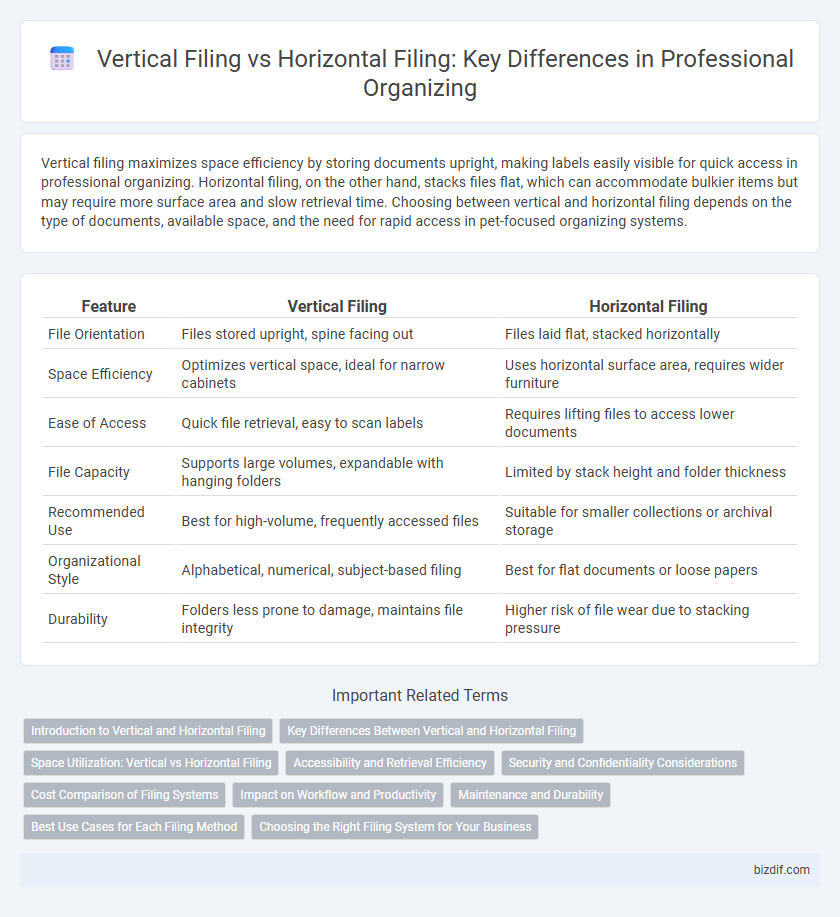Vertical filing maximizes space efficiency by storing documents upright, making labels easily visible for quick access in professional organizing. Horizontal filing, on the other hand, stacks files flat, which can accommodate bulkier items but may require more surface area and slow retrieval time. Choosing between vertical and horizontal filing depends on the type of documents, available space, and the need for rapid access in pet-focused organizing systems.
Table of Comparison
| Feature | Vertical Filing | Horizontal Filing |
|---|---|---|
| File Orientation | Files stored upright, spine facing out | Files laid flat, stacked horizontally |
| Space Efficiency | Optimizes vertical space, ideal for narrow cabinets | Uses horizontal surface area, requires wider furniture |
| Ease of Access | Quick file retrieval, easy to scan labels | Requires lifting files to access lower documents |
| File Capacity | Supports large volumes, expandable with hanging folders | Limited by stack height and folder thickness |
| Recommended Use | Best for high-volume, frequently accessed files | Suitable for smaller collections or archival storage |
| Organizational Style | Alphabetical, numerical, subject-based filing | Best for flat documents or loose papers |
| Durability | Folders less prone to damage, maintains file integrity | Higher risk of file wear due to stacking pressure |
Introduction to Vertical and Horizontal Filing
Vertical filing stores documents upright in drawers or folders, allowing for easy retrieval and space efficiency in compact office environments. Horizontal filing stacks documents flat, often in trays or bins, providing quick access to frequently used files but requiring more desk or shelf space. Choosing between vertical and horizontal filing depends on document volume, office layout, and workflow preferences.
Key Differences Between Vertical and Horizontal Filing
Vertical filing systems store documents upright in drawers, maximizing space efficiency and allowing for quick identification of files through visible tab labels. Horizontal filing lays papers flat, ideal for large, bulky items or documents that must remain unfolded, but typically requires more surface area and slower access times. The choice between vertical and horizontal filing depends on document size, frequency of access, and available office space, with vertical filing favored for routine document organization and horizontal for specialized storage needs.
Space Utilization: Vertical vs Horizontal Filing
Vertical filing maximizes space efficiency by allowing files to be stored upright in tight, narrow slots, making it easier to access and identify documents quickly. Horizontal filing, on the other hand, consumes more desk or shelf space as documents lay flat, often requiring additional room for stacking or spreading. Choosing vertical filing improves overall spatial optimization in office environments, especially where floor and surface areas are limited.
Accessibility and Retrieval Efficiency
Vertical filing enhances accessibility and retrieval efficiency by allowing users to view file labels exposed at eye level, which facilitates quick identification and selection. Horizontal filing often requires lifting or shifting documents, reducing speed and ease of access, especially in high-volume environments. Implementing vertical filing systems improves workflow by minimizing retrieval time and reducing physical strain.
Security and Confidentiality Considerations
Vertical filing systems enhance security and confidentiality by limiting visibility of documents, reducing the risk of unauthorized access due to their upright storage design. Horizontal filing, often associated with open trays, increases exposure to sensitive materials, making it less suitable for confidential files in professional settings. Implementing lockable vertical filing cabinets provides an added layer of protection, aligning with best practices for secure document management.
Cost Comparison of Filing Systems
Vertical filing systems typically incur lower initial costs due to standard-sized filing cabinets and simpler installation, making them budget-friendly for small offices. Horizontal filing requires larger, often custom furniture pieces that increase upfront expenses but can offer better accessibility and space optimization in the long term. Evaluating cost efficiency includes considering maintenance, space utilization, and scalability in addition to initial purchase prices.
Impact on Workflow and Productivity
Vertical filing systems enable quick access to documents by keeping files upright and visible, significantly reducing retrieval time and improving workflow efficiency. Horizontal filing trays, while suitable for temporary or active projects, can lead to clutter and slower document sorting, potentially disrupting productivity. Prioritizing vertical filing in office environments streamlines information retrieval, enhances workspace organization, and supports faster decision-making processes.
Maintenance and Durability
Vertical filing systems promote easier maintenance by allowing documents to be accessed and returned without disrupting the order, enhancing long-term organization efficiency. Horizontal filing, while offering larger storage capacity, often results in stacking that can lead to increased wear and tear on documents and folders over time. Vertical filing cabinets typically feature sturdier construction materials, such as steel frames, contributing to superior durability and extended lifespan in professional office environments.
Best Use Cases for Each Filing Method
Vertical filing is ideal for organizing documents that require quick access and frequent retrieval, such as client files and active project records, because it allows easy visibility of file tabs. Horizontal filing suits bulk storage of less frequently accessed materials like archived reports or reference papers, maximizing drawer space and supporting thicker documents. Choosing vertical filing enhances efficiency for daily workflow, while horizontal filing optimizes space for long-term storage and bulky files.
Choosing the Right Filing System for Your Business
Choosing the right filing system for your business depends on space, accessibility, and document types. Vertical filing maximizes space efficiency and allows easy visibility of file labels, ideal for limited office areas and quick retrieval. Horizontal filing suits large documents and archival storage, providing a flat surface for stacking but requiring more horizontal space.
vertical filing vs horizontal filing Infographic

 bizdif.com
bizdif.com